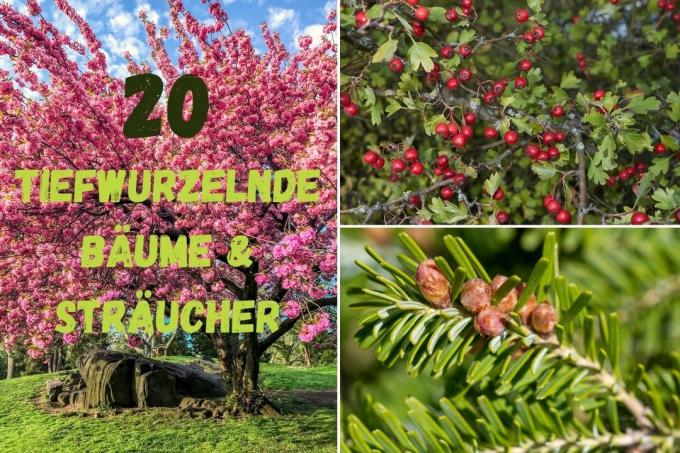
table of contents
- Typical for taproots
- Types from A - D
- Types of E - F
- Types of G - J
- Types of K - Z
- frequently asked Questions
Various trees and shrubs are only shallowly rooted in the ground. Others are deeply rooted. They are called taproots. These have a long tap root that protrudes deep into the ground. Below are a few examples.
In a nutshell
- a taproot is a long main root
- it grows vertically deep into the ground
- Taproots are well anchored in the ground
- easily adapt to unfavorable conditions
- Lilac, pine and silver fir are deep-rooted
Typical for taproots
Tap roots belong to the group of deep roots. A long and strong main root is characteristic of this root system. This developed from the radicle and grows vertically deep into the soil. Various side roots arise obliquely or sometimes horizontally from the taproot. It is a heterogeneous root system. Plants with such a root system can easily adapt to extremely unfavorable locations. The most common natural areas of distribution of such taproots are therefore mostly in regions that are dry in summer. They do not make any special demands on the floors. They grow on sandy, loose or gravelly surfaces. Here in particular, they need a firm anchorage so that they do not tip over in stormy times.
Note: Many heart roots also develop a taproot at a young age. With increasing age, many strong side shoots are formed as with the Real walnut (Juglans regia).
Types from A - D
American yellowwood (Cladrastis lutea)
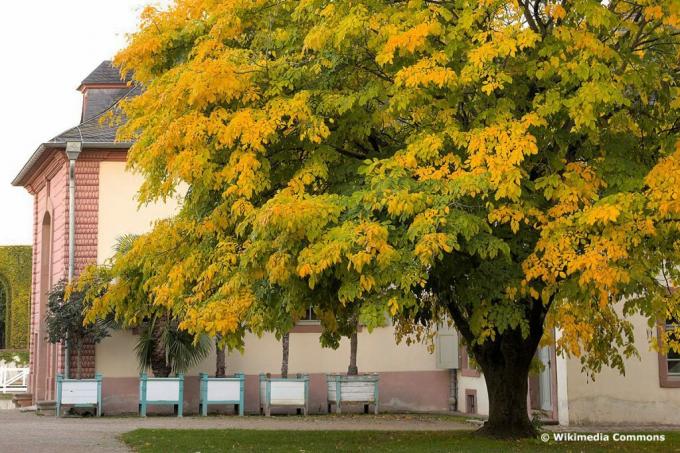
- Habit: multi-stemmed trees, short trunk, wide round crown
- Growth height: 600 to 1000 cm
- Flowers: May to June, white, fragrant
- Fruits: September, light brown fruit pods, 8 cm long
- Location: full sun
- Soil: fresh, deep, nutritious
- Special feature: yellow smooth wood, bee-friendly
Mountain elm (Ulmus glabra)

- Habit: deciduous tree, dense, broadly spreading
- Height: 2500 to 3500 cm
- Flowers: March to April, brown-violet
- Fruits: from May, winged green nuts
- Location: sun to partial shade
- Soil: well drained, rich in nutrients, calcareous
Common broom (Cytisus scoparius)
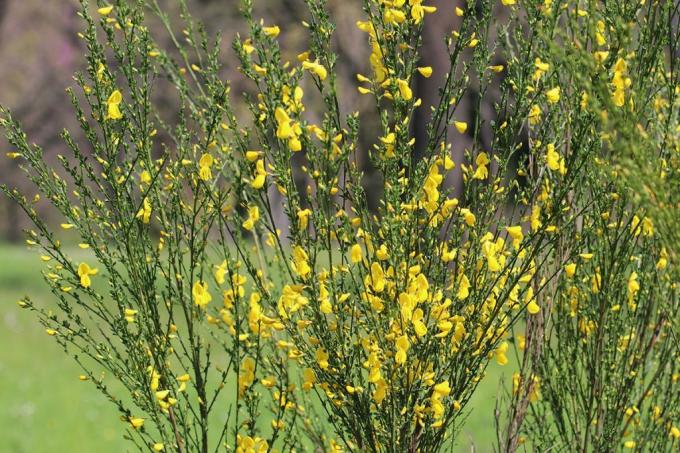
- Habit: upright shrub, broad, later overhanging branches
- Height: 150 to 200 cm
- Flowers: May to June, yellow and red shades
- Fruits: from August / September, legumes with seeds
- Location: sun
- Soil: sandy to normal garden soil
- Special feature: insect-friendly, also suitable as a container plant
Common pear (Pyrus communis)

- Habit: trees, sparsely branched, high-arched crown
- Height: 500 to 1500 cm
- Flowers: April to May, white
- Fruits: September to October, pear-shaped
- Location: sun to partial shade
- Soil: deep, rich in nutrients
Note: In the case of prolonged drought, watering is necessary. The trees need regular pruning.
Bluebell tree (Paulownia tomentosa)
Emperor tree

- Habit: deciduous tree, rigid shoots, loose broad crown
- Height: 800 to 1500 cm
- Flowers: April to May, violet-blue, fragrant
- Fruits: from September, fruit capsules with seeds, gray-brown
- Location: sun
- Soil: moderately dry to fresh, well-drained, gravelly - sandy, slightly acidic to strongly alkaline
Types of E - F
Real hawthorn "Paul's Scarlet" (Crataegus laevigata "Paul's Scarlet)

- Habit: large shrub or small trees, broadly conical, thorny shoots
- Growth height: 400 to 600 cm
- Flowers: May to June, dark red, double
- Fruits: from September, rarely, brick-red chokeberries
- Location: sun to partial shade
- Soil: rich in nutrients, moderately dry to moist, loamy clay
Yew tree (Taxus baccata)

- Habit: upright bush, densely branched, evergreen
- Height: 200 to 1000 cm
- Flowers: May to April, male as spherical catkins, female inconspicuous
- Fruits: September to October, small red pseudo-berries
- Location: sun to shade
- Soil: lime-tolerant, moist, no waterlogging
- Special feature: all parts of the plant are highly poisonous
Common hawthorn (Crataegus monogyna)

- Habit: large shrub or small tree, dense, shoots thorny
- Height: 200 to 500 cm
- Flowers: May to June, white, fragrant
- Fruits: September, scarlet apple fruits, edible, sour-sweet taste
- Location: sun to shade
- Soil: calcareous, rich in nutrients
- Special feature: good bird food and protective wood
Service tree (Sorbus torminalis)

- Habit: upright tree, dense crown
- Height: 800 to 1500 cm
- Flowers: May to June, white, fragrant
- Fruits: from October, small apple fruits, brown, sour taste
- Location: sun to partial shade
- Soil: well-drained, nutritious, calcareous, dry to fresh
- Special feature: good tree for feeding birds
Sweet chestnut (Castanea sativa)
Sweet chestnut, chestnut
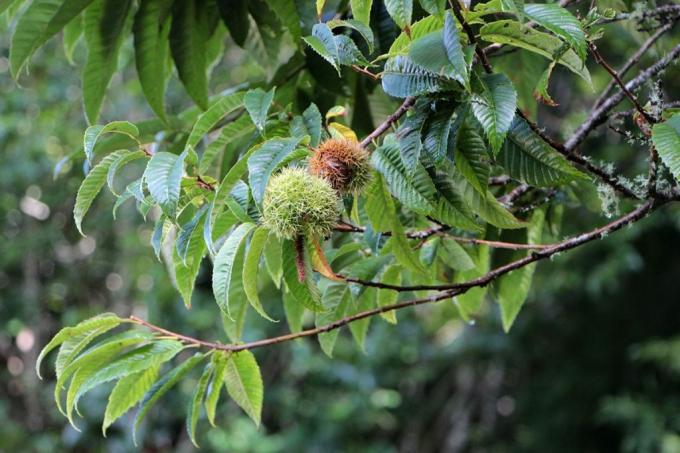
- Habit: deciduous trees, strong, dense
- Height: 1500 to 2000 cm
- Flowers: June to July, greenish white
- Fruits: harvest September to October, nuts 2 to 3 cm in size, mild, aromatic taste
- Location: sun to partial shade
- Soil: sandy-loamy, slightly acidic, fresh, rich in nutrients
- Special feature: fruits can be stored until March, bee-friendly wood
Types of G - J
Common lilac (Syringa vulgaris)

- Habit: large shrub or small tree, upright, densely branched
- Height: 250 to 700 cm
- Flowers: April to June, blue-violet, strongly scented
- Fruits: September to October, brown fruit capsules with seeds
- Location: sun to partial shade
- Soil: dry, fresh, well-drained, rich in nutrients, sandy-humic
- Special feature: forming runners, strongly overgrown
Common Juniper (Juniperus communis)
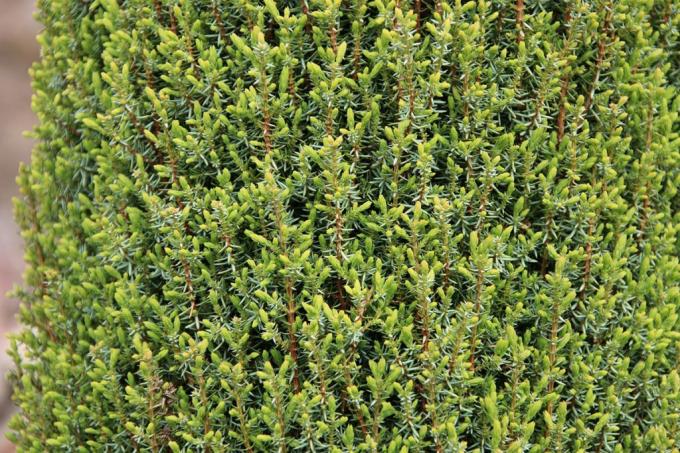
- Habit: tree or shrub, branched trunk, evergreen
- Height: 100 to 800 cm
- Flowers: April to June, egg-shaped, male yellowish, female inconspicuous greenish
- Fruits: August to October, spherical bluish berry cones
- Location: sun to partial shade
- Soil: well-drained, dry, poor in nutrients, weakly alkaline to slightly acidic
- Special feature: toxic to humans
Common Judas Tree (Cercis siliquastrum)

- Habit: shrub, more rarely trees, funnel-shaped
- Height: 200 to 600 cm
- Flowers: April to May, purple-pink, fragrant
- Fruits: from September, brown legumes, slightly poisonous
- Location: sun to partial shade
- Soil: calcareous, not too rich in nutrients, loose
Dog rose (Rosa canina)

- Habit: upright shrub, hanging branches
- Height: 200 to 300 cm
- Flowers: June to July, white-pink, slightly fragrant
- Fruits: from September, light to scarlet rose hips
- Location: sun to shade
- Soil: deep, rich in nutrients
- Special feature: rose hips with a high vitamin C content
Japanese clove cherry (Prunus serrulata)

- Habit: tree or shrub, funnel-shaped crown
- Growth height: 500 to 1000 cm
- Flowers: April to May, pink, double
- Fruits: from July, oval to round, purple to black, edible
- Location: sun
- Soil: deep, loose, sandy-loamy, slightly calcareous
Types of K - Z
Pine

- Habit: conifers, evergreen, loose branches, umbrella-shaped to conical crown
- Height: 1500 to 4000 cm
- Flowers: May to June, female reddish at the end of the short shoots, male red to reddish brown
- Fruits: September to October, egg-shaped cones, stalked
- Location: full sun
- Soil: sandy-loamy, strongly acidic to alkaline
- Special feature: very adaptable to all locations
Quince (Cydonia oblonga)
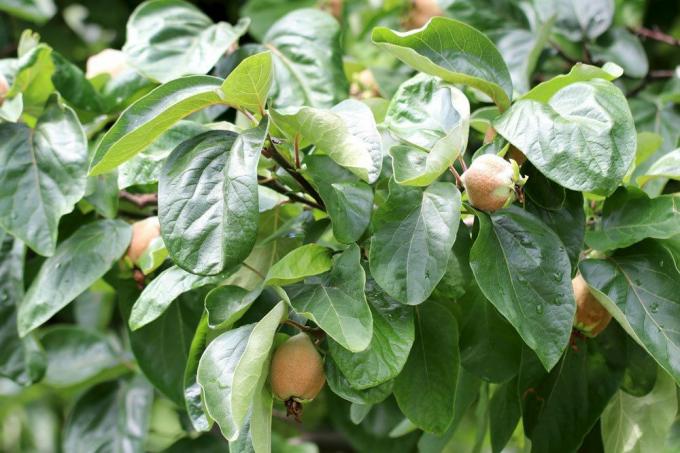
- Habit: smaller trees and bushes, sparsely branched
- Height: 200 to 400 cm
- Flowers: April to June, simply white
- Fruits: harvest October, yellow, apple-like, sweet-aromatic taste
- Location: sun to partial shade
- Soil: well-drained, normal garden soil
Note: Quince trees grow quite slowly and therefore hardly need any maintenance.
Sea buckthorn (Hippophae rhamnoides)

- Habit: Large shrub, sparsely branched, thorny shoots
- Height: 200 to 500 cm
- Flowers: April to May, brown
- Fruits: August to September, orange, egg-shaped to cylindrical, sour taste
- Location: sun to partial shade
- Soil: sandy, loose, well-drained
- Special feature: fruits with a high vitamin C content, bird protection trees
English oak (Quercus robur)
German oak
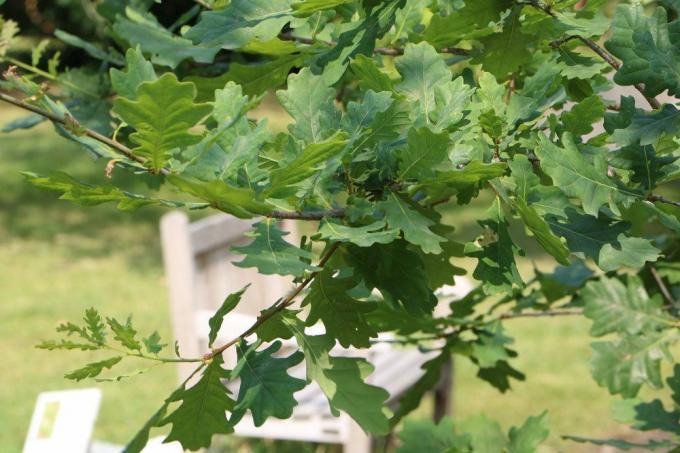
- Habit: tree, round crown, short trunk
- Height: 2500 to 3500 cm
- Flowers: May, greenish
- Fruits: from September, stalked acorns, 2 to 3.5 cm long
- Location: sun to partial shade
- Soil: nutrient-rich, loamy, deep, calcareous, moderately acidic
European silver fir (Abies alba)

- Habit: conifer, evergreen, upright
- Height: 1000 to 5000 cm
- Flowers: April to June, yellow catkins
- Fruits: September to October, cones upright on branches, 14 cm long
- Location: sun to partial shade
- Soil: moist, humic, acidic to alkaline
- Special feature: good bird protection and nutrient wood
frequently asked Questions
Since they are deeply rooted, they have a higher stability. The roots do not spread too much and so cannot cause damage to structures or terraces. Since they draw water from deeper regions of the earth, they can easily be planted under. They also contribute to soil improvement.
Problems can arise with older trees, because the roots must not be damaged. Since it goes deep into the ground, excavation is very difficult. Therefore, trees and shrubs that are deeply rooted should only be transplanted at a young age. They shouldn't be older than three years. Otherwise it can happen that older trees will not grow back.
Since these plants are deep-rooted, the choice of location must be made carefully. Later transplanting is not recommended. It is important that such plants are not planted directly over pipes or cables laid underground. In time they would destroy them. Of course, depending on the size, a certain distance to the neighboring property etc. be respected.

